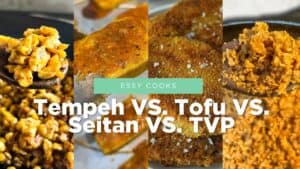Are you wonder what is tempeh, or how do I cook with it? Look no further you have come to the right place. Tempeh is a traditional Indonesian food made from fermented soybeans. This versatile ingredient has a nutty and earthy flavor that appeals to many vegans, vegetarians, and anyone exploring plant-based foods.
Packed with plant-based protein, essential amino acids, and a variety of nutrients, tempeh is an excellent way to add a complete protein to your diet. In this post, we’ll delve into its health benefits, how to cook it, and creative ways to enjoy it.
The Nutritional Breakdown of Tempeh
What Is Tempeh Nutritional Breakdown
Tempeh is a nutritional powerhouse. Made primarily from whole soybeans, it offers an impressive amount of plant-based protein, dietary fiber, and beneficial bacteria due to the fermentation process. Here’s a closer look at its nutritional profile:
| Nutrient | Amount per 100g |
|---|---|
| Calories | 193 |
| Protein | 18g |
| Fat | 14g |
| Carbohydrates | 8g |
| Fiber | 4g |
| Iron | 3.9mg |
| Calcium | 106mg |
| Vitamin B12 | 1.3mcg |
The fermentation process breaks down anti-nutrients in the soybeans, making the vitamins and minerals more bioavailable. This process also introduces probiotics, beneficial bacteria that support gut health. With its high protein content and inclusion of all essential amino acids, tempeh stands out as a complete source of protein in vegan and vegetarian diets.
Health Benefits of Tempeh
Tempeh’s nutrient density provides a variety of health benefits:
Low in Saturated Fats: As a soy-based product, it’s a heart-healthy option for reducing saturated fats in your diet.
High Protein Content: With around 18 grams of protein per 100 grams, tempeh is a fantastic choice for those following a plant-based diet.
Rich in B Vitamins: These vitamins are essential for energy production, brain health, and cellular function.
Good Source of Dietary Fiber: Tempeh supports digestive health and helps maintain healthy cholesterol levels.
Supports Bone Health: Calcium, along with other nutrients, makes tempeh a good alternative to dairy-based sources of calcium.
Promotes Gut Health: The probiotics in fermented tempeh can boost your digestive system and improve overall gut health.

How to Cook Tempeh
Tempeh is easy to cook and can be used in a variety of dishes. The most common way to prepare is by steaming or boiling it for around 10 minutes before using it in a recipe. This helps to remove any bitterness and also makes it easier to cut or crumble. After steaming, you can, airfry, pan-fry, grill, or bake the tempeh to add some crispy texture.
Other Ways To Cook Tempeh
Cooking tempeh is straightforward, and its firm texture and nutty taste make it a versatile ingredient in many dishes. Here are some popular methods for preparing it:
- Steaming or Boiling
- Steaming fresh or store-bought tempeh for 10 minutes is often the first step. This helps to soften its texture, remove any bitterness, and make it easier to work with. A steamer basket is a great tool for this.
- Pan-Frying
- Slice or crumble the tempeh and pan-fry it with a little oil over medium-high heat. This method enhances its meaty texture and develops a delicious crispy exterior. Add soy sauce or maple syrup for an umami-rich flavor boost.
- Baking
- Marinate your tempeh with your favorite seasonings and bake it at 375°F for 20-25 minutes. Baking gives it a firmer texture and allows the flavors to infuse deeply.
- Grilling
- Tempeh’s firm texture makes it perfect for grilling. Brush slices with oil and your choice of marinade, then grill until charred and heated through.
- Air-Frying
- For a quicker option, air-fry marinated tempeh at 400°F for 10-15 minutes. It’s a convenient way to achieve a crispy, golden finish without added oil.
- Crumbled or Sautéed
- Uncooked tempeh can be crumbled into dishes like tacos, spaghetti, or chili. Sauté it with spices and sauces for a meaty texture that’s a great meat substitute.


Eating Tempeh
There are countless ways to enjoy tempeh. Use it in stir-fries, salads, sandwiches, or soups. It’s also a popular choice for vegan bacon, thanks to its nutty flavor and ability to soak up smoky marinades. Pair it with soy sauce, hoisin, or balsamic vinegar for a variety of flavor profiles.
For those following vegan or vegetarian diets, tempeh is a good alternative to meat in dishes like tacos, burgers, or casseroles. Its meaty texture and high protein content make it a staple source of protein for many plant-based eaters.


All Plant-Based Tempeh Recipes
Conclusion: What is Tempeh
Tempeh is more than just a fermented soybean product—it’s a versatile, nutrient-dense food that fits seamlessly into a plant-based diet. Whether you’re steaming, frying, or baking it, tempeh’s nutty taste and firm texture make it a satisfying addition to a variety of recipes.
With its high protein content, essential amino acids, and variety of health benefits, it’s no wonder tempeh has become a staple food for those seeking a complete source of vegan protein. So, next time you’re at health food stores or browsing the soy products aisle, don’t hesitate to grab some tempeh and explore the endless possibilities!
Source For Health Benefits of Tempeh
The information in the blog post about tempeh was gathered from a variety of sources including scientific studies, nutrition websites, and articles written by health professionals and food experts. Some sources that were used include the USDA National Nutrient Database, Healthline, and Medical News Today. Keep in mind that the information provided is for general educational purposes only, and should not be used as a substitute for professional medical advice, diagnosis, or treatment. Always seek the advice of a qualified healthcare provider before making any changes to your diet or exercise routine.










